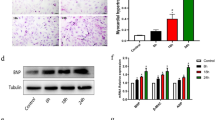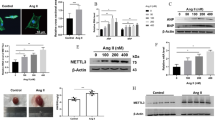Abstract
Although matrix metalloproteinase-9 (MMP‐9) is involved in cardiomyocytes contractility dysfunction, tissue inhibitor of metalloproteinase-4 (TIMP‐4) mitigates the effect of MMP‐9, and proteinase-activated receptor-1 (PAR‐1, a G-protein couple receptor, GPCR) is involved in the signaling cascade of MMP‐9-mediated cardiac dysfunction, the mechanism(s) are unclear. To test the hypothesis that induction of dicer and differential expression of microRNAs (miRNAs) contribute, in part, to the down regulation of sarcoplasmic reticulum calcium ATPase isoform 2a (serca-2a) in MMP-9 and PAR-1-mediated myocytes dysfunction, ventricular cardiomyocytes were isolated from C57BL/6J mice and treated with 3 ng/ml of MMP-9, 12 ng/ml of TIMP-4, and 10 and 100 μM of PAR-1 antagonist with MMP-9. Specific role of MMP-9 was determined by using MMP-9 knock out (MMP-9KO) and their corresponding control (FVB) mice. Ion Optics video-edge detection system and Fura 2-AM loading were used for determining the contractility and calcium release from cardiomyocytes. Quantitative and semi-quantitative PCR were used to determine the expression of dicer, TIMP-4 and serca-2a. miRNA microarrays were used for assessing the expression of different miRNAs between MMP-9KO and FVB cardiomyocytes. The results suggest that MMP‐9 treatment attenuates the voltage‐induced contraction of primary cardiomyocytes while TIMP‐4, an inhibitor of MMP‐9, reverses the inhibition. MMP‐9 treatment is also associated with reduced Ca2+ transients. This effect is blocked by a PAR‐1 antagonist, suggesting that PAR‐1 mediates this effect. The effect is not as great at high concentrations (100 μM) perhaps due to mild toxicity. The PAR‐1 antagonist effect did not affect calcium transients unlike TIMP‐4. Interestingly, we show that MMP‐KO myocytes contract more rapidly and release more Ca2+ than FVB. The relevant RNA species serca-2a is induced and dicer is inhibited. There is selective inhibition of miR-376b and over-expression of miR-1, miR-26a, miR-30d, and miR-181c in MMP‐9KO that are implicated in regulation of G-PCR and calcium handling.








Similar content being viewed by others
References
Tyagi, S. C., & Hoit, B. D. (2002). Metalloproteinase in myocardial adaptation and maladaptation. Journal of Cardiovascular Pharmacology and Therapeutics, 7, 241–246.
Ali, M. A., & Schulz, R. (2009). Activation of MMP-2 as a key event in oxidative stress injury to the heart. Frontiers in Bioscience, 14, 699–716.
Macfarlane, S. R., Seatter, M. J., Kanke, T., Hunter, G. D., & Plevin, R. (2001). Proteinase-activated receptors. Pharmacological Reviews, 53, 245–282.
Sabri, A., Muske, G., Zhang, H., Pak, E., Darrow, A., Andrade-Gordon, P., et al. (2000). Signaling properties and functions of two distinct cardiomyocyte protease-activated receptors. Circulation Research, 86, 1054–1061.
Elkington, P. T., & Friedland, J. S. (2006). Matrix metalloproteinases in destructive pulmonary pathology. Thorax, 61, 259–266.
Graham, H. K., Horn, M., & Trafford, A. W. (2008). Extracellular matrix profiles in the progression to heart failure. European Young Physiologists Symposium Keynote Lecture-Bratislava 2007. Acta Physiol (Oxf), 194, 3–21.
Kumar, S., Kain, V., & Sitasawad, S. L. (2009). Cardiotoxicity of calmidazolium chloride is attributed to calcium aggravation, oxidative and nitrosative stress, and apoptosis. Free Radical Biology and Medicine, 47, 699–709.
Khan, H., Metra, M., Blair, J. E., Vogel, M., Harinstein, M. E., Filippatos, G. S., et al. (2009). Istaroxime, a first in class new chemical entity exhibiting SERCA-2 activation and Na-K-ATPase inhibition: A new promising treatment for acute heart failure syndromes? Heart Failure Reviews, 14, 277–287.
Ide, J., Aoki, T., Ishivata, S., Glusa, E., & Strukova, S. M. (2007). Proteinase-activated receptor agonists stimulate the increase in intracellular Ca2+ in cardiomyocytes and proliferation of cardiac fibroblasts from chick embryos. Bulletin of Experimental Biology and Medicine, 144, 760–763.
Mishra, P. K., Tyagi, N., Kumar, M., & Tyagi, S. C. (2009). MicroRNAs as a therapeutic target for cardiovascular diseases. Journal of Cellular and Molecular Medicine, 13, 778–789.
Latronico, M. V., Catalucci, D., & Condorelli, G. (2007). Emerging role of microRNAs in cardiovascular biology. Circulation Research, 101, 1225–1236.
Chen, J. F., Murchison, E. P., Tang, R., Callis, T. E., Tatsuguchi, M., Deng, Z., et al. (2008). Targeted deletion of dicer in the heart leads to dilated cardiomyopathy and heart failure. Proceedings of the National Academy of Sciences of the United States of America, 105, 2111–2116.
Ye, G., Metreveli, N. S., Donthi, R. V., Xia, S., Xu, M., Carlson, E. C., et al. (2004). Catalase protects cardiomyocyte function in models of type 1 and type 2 diabetes. Diabetes, 53, 1336–1343.
Mishra, P. K., Tyagi, N., Kundu, S., & Tyagi, S. C. (2009). MicroRNAs are involved in homocysteine-induced cardiac remodeling. Cell Biochemistry and Biophysics, 55, 153–162.
Moshal, K. S., Tyagi, N., Henderson, B., Ovechkin, A. V., & Tyagi, S. C. (2005). Protease-activated receptor and endothelial-myocyte uncoupling in chronic heart failure. American Journal of Physiology. Heart and Circulatory Physiology, 288, H2770–H2777.
Moshal, K. S., Tipparaju, S. M., Vacek, T. P., Kumar, M., Singh, M., Frank, I. E., et al. (2008). Mitochondrial matrix metalloproteinase activation decreases myocyte contractility in hyperhomocysteinemia. American Journal of Physiology. Heart and Circulatory Physiology, 295, H890–H897.
Leon, H., Baczko, I., Sawicki, G., Light, P. E., & Schulz, R. (2008). Inhibition of matrix metalloproteinases prevents peroxynitrite-induced contractile dysfunction in the isolated cardiac myocyte. British Journal of Pharmacology, 153, 676–683.
Schultz, J. J., Glascock, B. J., Witt, S. A., Nieman, M. L., Nattamai, K. J., Liu, L. H., et al. (2004). Accelerated onset of heart failure in mice during pressure overload with chronically decreased SERCA2 calcium pump activity. American Journal of Physiology. Heart and Circulatory Physiology, 286, H1146–H1153.
Wisloff, U., Loennechen, J. P., Falck, G., Beisvag, V., Currie, S., Smith, G., et al. (2001). Increased contractility and calcium sensitivity in cardiac myocytes isolated from endurance trained rats. Cardiovascular Research, 50, 495–508.
Acknowledgment
A part of this study was supported by NIH grants: HL-74185 and HL-88012.
Author information
Authors and Affiliations
Corresponding author
Rights and permissions
About this article
Cite this article
Mishra, P.K., Metreveli, N. & Tyagi, S.C. MMP-9 Gene Ablation and TIMP-4 Mitigate PAR-1-Mediated Cardiomyocyte Dysfunction: A Plausible Role of Dicer and miRNA. Cell Biochem Biophys 57, 67–76 (2010). https://doi.org/10.1007/s12013-010-9084-1
Published:
Issue Date:
DOI: https://doi.org/10.1007/s12013-010-9084-1




